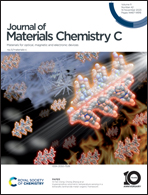Hypersensitive ratiometric temperature sensing in a bimetallic lanthanide metal–organic framework†
Abstract
Ratiometric luminescent temperature sensing based on a single matrix is highly desirable at present. However, the adjustments of the temperature response range and sensitivity are still a huge challenge. Herein, a novel series of isostructural three-dimensional (3D) lanthanide metal–organic frameworks (Ln-MOFs) {[Ln4(ebdc)6(DMF)2.75(H2O)7]}n (HPU-99, where Ln = Eu and EuxTb1−x, H2ebdc = 5-ethynyl-isophthalic acid) are synthesized by a solvothermal method using a 5-ethynyl-isophthalic acid ligand (H2ebdc). Notably, a series of Ln-MOFs EuxTb1−x-HPU-99 (x = 0.05, 0.1, 0.2) are obtained by adjusting the proportion of Eu3+/Tb3+ in the bimetallic materials, which exhibit temperature dependent luminescent behavior with a fluorescence color gradient and demonstrate that chemical components would affect the ratiometric luminescent temperature sensing performance. Furthermore, the luminescence of HPU-99 is altered after the argentophilic alkynyl groups anchor the silver nanoclusters (Ag NCs). This work showcases that bimetallic Ln-MOFs have great potential in luminescent sensing at an atomically precise level.

- This article is part of the themed collection: 2023 Journal of Materials Chemistry C HOT Papers


 Please wait while we load your content...
Please wait while we load your content...